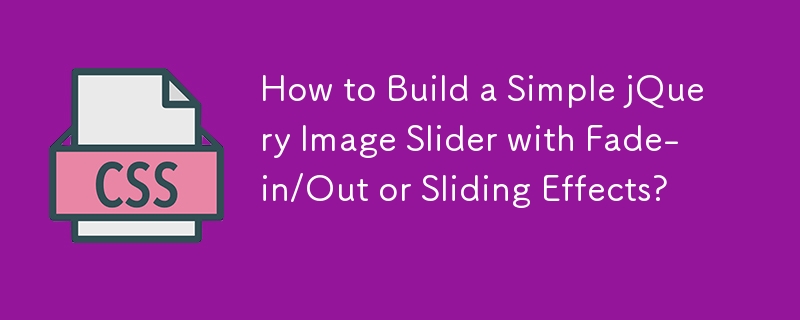 Web Front-end
Web Front-end
 CSS Tutorial
CSS Tutorial
 How to Build a Simple jQuery Image Slider with Fade-in/Out or Sliding Effects?
How to Build a Simple jQuery Image Slider with Fade-in/Out or Sliding Effects?
How to Build a Simple jQuery Image Slider with Fade-in/Out or Sliding Effects?
Nov 26, 2024 am 09:37 AM
Guide to Creating a Simple jQuery Image Slider with Fade-in/Out or Sliding Effects
Introduction
Instead of relying on bulky plugins, some developers prefer custom jQuery solutions for image sliders to maintain flexibility and minimize conflicts. This article provides a detailed guide on how to build a simple and customizable jQuery image slider.
Effects and jQuery Functions
Before delving into the code, let's understand two key jQuery functions:
- index(): Returns the position of an element relative to its siblings.
- eq(): Selects an element based on its position (index value).
Effect Implementation
Fade-in/Fade-out Effect
- HTML: Set up a list of
- elements for images and triggers.
- CSS: Overlap images with position:absolute to create the fading effect.
- jQuery: Manipulate images using .fadeIn() and .fadeOut() based on the trigger index.
Sliding Effect
- HTML: Create a double-wrapped structure for the image container.
- CSS: Set the width of the outer wrapper to the combined width of all images.
- jQuery: Animate the position of the inner wrapper to slide the images.
Common jQuery Response
Regardless of the effect, both sliders utilize similar jQuery commands:
- Trigger Clicks: Handle clicks on the trigger elements to display the corresponding image.
- Next/Prev Clicks: Navigate between images using the next and prev controls.
- Timing: Implement optional automatic slide transitions using setInterval().
Conclusion
Using these simple techniques, you can build a versatile jQuery image slider that suits your specific needs. The provided HTML, CSS, and jQuery code offer a solid foundation for customizing your sliders with different effects and navigation options.
The above is the detailed content of How to Build a Simple jQuery Image Slider with Fade-in/Out or Sliding Effects?. For more information, please follow other related articles on the PHP Chinese website!

Hot AI Tools

Undress AI Tool
Undress images for free

Undresser.AI Undress
AI-powered app for creating realistic nude photos

AI Clothes Remover
Online AI tool for removing clothes from photos.

Clothoff.io
AI clothes remover

Video Face Swap
Swap faces in any video effortlessly with our completely free AI face swap tool!

Hot Article

Hot Tools

Notepad++7.3.1
Easy-to-use and free code editor

SublimeText3 Chinese version
Chinese version, very easy to use

Zend Studio 13.0.1
Powerful PHP integrated development environment

Dreamweaver CS6
Visual web development tools

SublimeText3 Mac version
God-level code editing software (SublimeText3)

Hot Topics
 How can I include CSS only on some pages?
Jun 11, 2025 am 12:01 AM
How can I include CSS only on some pages?
Jun 11, 2025 am 12:01 AM
There are three ways to selectively include CSS on a specific page: 1. Inline CSS, suitable for pages that are not frequently accessed or require unique styles; 2. Load external CSS files using JavaScript conditions, suitable for situations where flexibility is required; 3. Containment on the server side, suitable for scenarios using server-side languages. This approach can optimize website performance and maintainability, but requires balance of modularity and performance.
 Flexbox vs Grid: Understanding the Key Differences in CSS Layout
Jun 10, 2025 am 12:03 AM
Flexbox vs Grid: Understanding the Key Differences in CSS Layout
Jun 10, 2025 am 12:03 AM
Flexboxisidealforone-dimensionallayouts,whileGridsuitstwo-dimensional,complexlayouts.UseFlexboxforaligningitemsinasingleaxisandGridforprecisecontroloverrowsandcolumnsinintricatedesigns.
 Creating an Auto-Closing Notification With an HTML Popover
Jun 10, 2025 am 09:45 AM
Creating an Auto-Closing Notification With an HTML Popover
Jun 10, 2025 am 09:45 AM
The HTML popover attribute transforms elements into top-layer elements that can be opened and closed with a button or JavaScript. Popovers can be dismissed a number of ways, but there is no option to auto-close them. Preethi has a technique you can u
 What is 'render-blocking CSS'?
Jun 24, 2025 am 12:42 AM
What is 'render-blocking CSS'?
Jun 24, 2025 am 12:42 AM
CSS blocks page rendering because browsers view inline and external CSS as key resources by default, especially with imported stylesheets, header large amounts of inline CSS, and unoptimized media query styles. 1. Extract critical CSS and embed it into HTML; 2. Delay loading non-critical CSS through JavaScript; 3. Use media attributes to optimize loading such as print styles; 4. Compress and merge CSS to reduce requests. It is recommended to use tools to extract key CSS, combine rel="preload" asynchronous loading, and use media delayed loading reasonably to avoid excessive splitting and complex script control.
 How to use Lotties in Figma
Jun 14, 2025 am 10:17 AM
How to use Lotties in Figma
Jun 14, 2025 am 10:17 AM
In the following tutorial, I will show you how to create Lottie animations in Figma. We'll use two colorful designs to exmplify how you can animate in Figma, and then I'll show you how to go from Figma to Lottie animations. All you need is a free Fig
 Breaking Boundaries: Building a Tangram Puzzle With (S)CSS
Jun 13, 2025 am 11:33 AM
Breaking Boundaries: Building a Tangram Puzzle With (S)CSS
Jun 13, 2025 am 11:33 AM
We put it to the test and it turns out Sass can replace JavaScript, at least when it comes to low-level logic and puzzle behavior. With nothing but maps, mixins, functions, and a whole lot of math, we managed to bring our Tangram puzzle to life, no J
 External vs. Internal CSS: What's the Best Approach?
Jun 20, 2025 am 12:45 AM
External vs. Internal CSS: What's the Best Approach?
Jun 20, 2025 am 12:45 AM
ThebestapproachforCSSdependsontheproject'sspecificneeds.Forlargerprojects,externalCSSisbetterduetomaintainabilityandreusability;forsmallerprojectsorsingle-pageapplications,internalCSSmightbemoresuitable.It'scrucialtobalanceprojectsize,performanceneed
 Does my CSS must be on lower case?
Jun 19, 2025 am 12:29 AM
Does my CSS must be on lower case?
Jun 19, 2025 am 12:29 AM
No,CSSdoesnothavetobeinlowercase.However,usinglowercaseisrecommendedfor:1)Consistencyandreadability,2)Avoidingerrorsinrelatedtechnologies,3)Potentialperformancebenefits,and4)Improvedcollaborationwithinteams.





